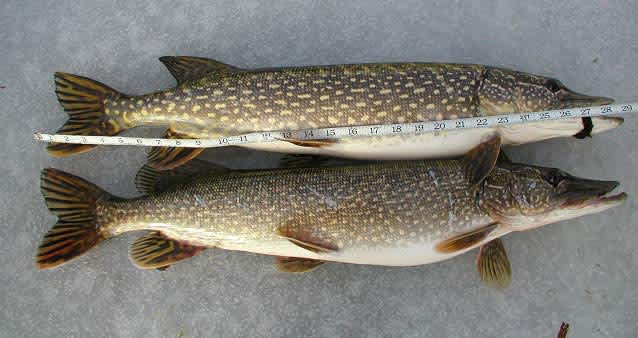Pike Through the Ice: One Michigan Family’s Tradition
Steve Griffin 12.28.12

Many Michigan anglers are versatile, multi-season, multi-species generalists. Not so much, members of the Fillmore family.
“We were raised on a farm,” said my friend Don Fillmore, who now lives in Coleman but was raised in rural Hope. “There wasn’t time to fish in the summer, except maybe at summer camp.”
Fishing, then, meant ice fishing. And ice fishing, despite an occasional mess of crappies, meant northern pike.
It still does.
When you’re on the ice with Don, Doug, or Ron Fillmore, or their nephews, including the sons of their late brother, Bill, everyone helps set tip-ups, and when the tip-up flags fly, they take turns battling fish. But determining those turns is a bit complex. Most times, it’s youngest to oldest. But sometimes it’s oldest to youngest. Either way, kids can keep trying, even if they miss or lose fish until they catch one. An adult misses a fish, and their turn’s over.

That latter case gives rise to vigorous, good-natured debates.
“It’s like CSI sometimes,” said Don in reference to the detective show. “A wind flag doesn’t lose you your turn. But if a fish hits the bait and drops it, you’re done. We’ve spent lots of time sometimes examining a minnow for the least sign, maybe a lost scale, that a fish caused the flag.”
A new system, developed last year, has each member of the party ‘drafting’ three tip-ups–the legal Michigan maximum–after they’re all set, and reaping their results the rest of the day.
Sometimes they go back to the rules of their youth: the fastest and toughest gets the action.
Some people make an intricate deal out of winter pike fishing, but it’s really pretty simple. Preferred gear is a tip-up loaded with braided line, ending in a monofilament or steel wire leader. Crossed-stick, tripod-based, bucket-stackable disks–the tip-up design and shape aren’t too important as long as the triggering mechanism will withstand the antics of a lively bait without triggering, and still release the flag when a pike strikes.
It’s your call, too, on leader material: mono generally seems to draw more strikes, wire is less likely to be severed by a toothy pike.
Add a treble hook of size 4 or so, and impale a big golden shiner. “Bait shops hate me,” says Don, “because I insist on picking my own.” Blues, grays, suckers and other minnows work, too, as do small bluegills caught when the regular bait runs out.

The best fishing spots are almost always on the deep side of a bed of still-green weeds, or a clear pocket within them. Weeds draw baitfish and provide cover for the camouflaged predators; what more could a pike want? Try the shallow side of the weeds, too, and stump fields in river impoundments.
Most sets are in waters two to 12 feet deep, and most baits hang about half-way down. Although they’ve got some new gear, many Fillmore rigs still have line run twice through a button so it can be slid up or down to mark the depth. That makes it easier to judge if a fish has struck but dropped a bait, or made a run before turning the bait in its mouth and swallowing it. It also makes it a breeze to re-set a productive tip-up.
A quick-strike rig, double hooking live or dead baits, removes the need to wait before setting the hook.
For winter fun, there’s little that can rival a pike party. Six or eight family members and friends, spreading three tip-ups each across a lake, aiming for the two-24-inch-plus fish allowed per angler under Michigan limits. A propane grill serves up brats or, if autumn’s been generous, venison steak slices for sandwiches.
It’s what the Fillmores mean when they say “fishing.”
For more information on Michigan fishing go to michigan.org.

